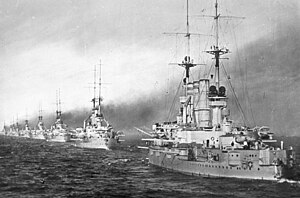Deutschland-class battleship

Deutschland-class battleships in line.
|
|
| Class overview | |
|---|---|
| Builders: | |
| Operators: | |
| Preceded by: | Braunschweig-class battleship |
| Succeeded by: | Nassau-class battleship |
| Built: | 1903–08 |
| In commission: | 1906–45 |
| Completed: | 5 |
| Lost: | 3 |
| Scrapped: | 2 |
| General characteristics | |
| Type: | Pre-dreadnought battleship |
| Displacement: |
|
| Length: | 127.60 m (418 ft 8 in) |
| Beam: | 22.20 m (72 ft 10 in) |
| Draft: | 8.21 m (26 ft 11 in) |
| Installed power: | 17,000 PS (13,000 kW; 17,000 ihp) |
| Propulsion: | three shafts, three triple expansion steam engines, 12 boilers |
| Speed: | 18.5 knots (34.3 km/h; 21.3 mph) |
| Range: | 4,800 nmi (8,900 km; 5,500 mi); 10 knots (19 km/h; 12 mph) |
| Complement: |
|
| Armament: |
|
| Armor: |
|
The Deutschland class was a group of five pre-dreadnought battleships built for the German Kaiserliche Marine. The class comprised Deutschland, Hannover, Pommern, Schlesien, and Schleswig-Holstein. Built between 1903 and 1908, the ships closely resembled those of the preceding Braunschweig class, though they had stronger armor protection. They were made obsolete before they were even completed by the launch of the revolutionary Royal Navy battleship HMS Dreadnought in 1906. As a result, they were the last ships of that type built for the German Navy. They were followed by the Nassau-class battleships, Germany's first dreadnought battleships.
With the commissioning of the Deutschland class, the fleet had enough battleships to form two full battle squadrons; the fleet was then reorganized into the High Seas Fleet, which saw combat during World War I. Despite their obsolescence, all five of these ships were present at the Battle of Jutland on 31 May – 1 June 1916. In the confused night actions, Pommern was torpedoed and sunk. After the battle, the four surviving ships were removed from the front-line fleet and employed in secondary tasks. The Treaty of Versailles permitted Germany to retain several old battleships for coastal defense, including the four Deutschland-class ships.
However, instead of being used as a coastal defense ship, Deutschland was broken up in 1920–1922. Hannover was to be converted into a target vessel, although this was never done. She was eventually broken up in 1944–1946. Schlesien and Schleswig-Holstein were the only two vessels of the class to see continued front-line service in the Reichsmarine and later the Kriegsmarine. Both ships saw limited duty during World War II, which was inaugurated by the firing of Schleswig-Holstein's main guns at the Polish fortress at Westerplatte. Near the end of the war the two ships were both sunk.
...
Wikipedia
